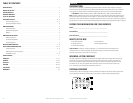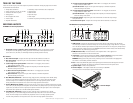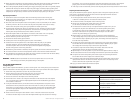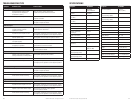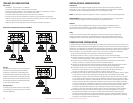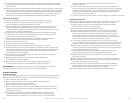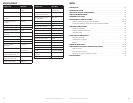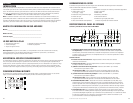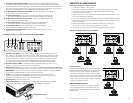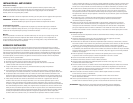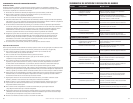
8 © 2011 Polk Audio—all rights reserved © 2011 Polk Audio—all rights reserved 9
9. Battery and ground connections to the vehicle should be made with crimped ring terminals of the appropriate
size (surface area is what counts;) soldering the terminals after crimping is also recommended.
10. Due to the high-frequency MOSFET switching power supply, filtering the power cable is not generally required
(remember that the amp can’t deliver full output if the power supply is restricted.) Proper grounding of the
signal source is mandatory for the amplifier to reach its performance peak. If the RCA inputs are not grounded
adequately via the signal source, electrical noise from the vehicle may be picked up in the system.
Step By Step Installation
1. Determine the location for the amplifier. Refer to the Mounting Locations section of this guide.
2. Decide on the system configuration for your amplifier. For system suggestions, refer to the Speaker
Wiring Diagrams section of this guide.
3. Run all the wires from the amplifier location to the speakers, source unit, and battery. Do not connect
the battery at this time. Be sure to run Line levels and power and speaker wires away from factory
electrical wires and system as they pose a great potential for induced system noise.
4. Pre-drill amplifier mounting holes. Be sure to “think before you drill.“ Gas tanks, fuel lines, and other
obstructions have a nasty way of hiding themselves. For best results use a marking pen to mark the
mountingholesandpre-drilltheseholeswithastandard1/8"drillbit.
5. Mount the amplifier. Make sure the amplifier is mounted on a flat surface. If this is not possible,
do not over tighten the screws so that the chassis of the amplifier is twisted or bent.
6. Turn the vehicle’s key switch to the off position.
7. Disconnect the vehicle’s battery ground terminal.
8. Connectpowerwirestotheamplifier(groundfirst,then+12VandREM).
9. Connect the line level and speaker wires to the amplifier. Check the quality of your speakers
and signal connections. This will determine the ultimate performance of your Polk Audio
PA D Series amplifier. Refer to the Line Level Inputs/Controls and Speaker Wiring Diagrams
sections of this guide for correct wiring instructions.
10. Reconnect the ground terminal to the battery after power, speaker, and line level connections are completed.
11. Set crossovers. Refer to the Line Level Inputs/Controls section of this manual for detailed instructions.
12. Once satisfied that all connections and settings are correct, install the fuse located near the vehicle’s battery
and proceed to the Testing the System section of this manual.
WARNING! NEvER exceed the recommended fuse size of this amplifier. Failure to do so will result
in the voiding of your warranty and possible damage to the amplifier.
SET UP AND TROUBLESHOOTING
Testing the System
After you have completed the installation, you need to test the system. This will help ensure years of trouble-free
operation. Please refer to the listed steps below when testing the sound of your Polk Audio PA D Series amplifier.
1. Check all the wiring connections to be sure they are correct and secure.
2. Turn the signal source volume control all the way down. Set any tone controls
to their flat or defeated positions. This includes the loudness control.
3. Turn the level controls of the amplifier to their minimum positions.
4. Turn the head unit on. Check to see if the power LED located on the connection side of the amplifier
is on. If not, please refer to the Power Inputs/Speaker Outputs and the Troubleshooting Tips sections
of this manual for instructions.
5. If using an aftermarket head unit, turn the level controls of the amplifier about one quarter of a turn
counterclockwise. Slowly increase the volume level of the head unit so that you can hear the output
of the system. If no sound is heard or if the output is distorted, turn the system off immediately. Refer
to the Power Inputs/Speaker Outputs and the Troubleshooting Tips sections of this manual to solve
your installation problems.
6. Check to make sure the output for each channel is correct. If the active crossovers are used, check
to make sure that each output is correct from the amplifier. When using active crossovers on midrange
and tweeters, do not use crossover frequencies lower than recommended. If the system is not configured
properly, refer to the Line Level Inputs/Controls section of this manual and take corrective action.
7. If the output is clear and undistorted, continue to the Adjusting the Sound of the System section of this manual.
Adjusting the Sound of the System
Once you have checked the system’s operation, adjust the sound of the system. Adjusting the sound
of the system is accomplished by setting the level controls and adjusting the internal crossovers
(see Line Level Inputs/Controls on page 4).
1. Turn the signal source volume control all the way down. Set any tone controls
to their flat or defeated positions. This includes the loudness control.
2. Turn the level controls of the amplifier to their minimum positions.
3. Choose music with high dynamic content that you like, with which
you are familiar, and will be used most often in the system.
4. Turn the head unit’s volume control up to its highest undistorted output level. If you lack
test equipment, this point occurs between 3/4 to full volume depending on the quality
of your head unit. Listen for any audible distortion. If any distortion is audible, reduce
the volume of the head unit until you have an undistorted output. Leave the volume
control at this position during your system tuning.
5. While listening to your chosen dynamic music, turn up the level control corresponding
to the midrange output until you hear slight distortion and turn the level control back slightly
for an undistorted output. Depending on your system, the midrange and tweeter output may
be on the same output channels.
6. Turn up the level control corresponding to the tweeter output until you hear slight distortion
and turn back the level control slightly for an undistorted output. Depending on your system
the midrange and tweeter output may be on the same output channels.
7. Fine-tune the output level between midrange and tweeters. Refer to the Line Level
Inputs/Controls section of this manual for detailed instructions.
8. Repeat Steps 5-7 for the rear speakers. If you do not have rear speakers continue to Step 10.
9. Set levels between the front and rear midrange and tweeters for optimum front/rear balance.
10. Turn up the level control corresponding to the woofer output until you hear slight distortion
and turn back the level control slightly for an undistorted output.
11. Fine-tune the output level between satellite speakers and the woofers. Refer to the Line Level
Inputs/Controls section of this manual for controls. Adjust the level to the bass output of the
woofer to match the sonic requirements of the system.
12. Enjoy your awesome Polk Audio PA D Series amplifier.
TROUBLESHOOTING TIPS
Symptom Probable Cause Action To Take
No output
Low or no remote turn-on. Check remote turn-on at amplifier and repair as needed.
Fuse blown. Check power wire’s integrity and check for
speaker shorts. Fix as needed and replace fuse.
Power wires not connected. Check power wire and ground connections
and repair or replace as needed.
Audio input not connected. Check line level connections and repair
or replace as needed.
Speaker wires not connected. Check speaker wires and repair or replace as needed.
Speakers are blown. Check system with known working speaker
and repair or replace speakers as needed.




